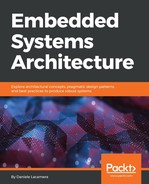The context switch procedure consists of getting the values of the CPU register during the execution and saving them at the bottom of the stack of the currently running task. Then, restore the values for the next task, to resume its execution. This operation must happen in the interrupt context, and its internal mechanisms are CPU-specific. On the reference platform, any interrupt handler can replace the current running task and restore another context, but this operation is more often done within interrupt service routines associated with system events. Cortex-M provides two CPU exceptions that are designed to provide the basic support for context switching, because they can be arbitrarily triggered in any context: PendSV and SVCall. The former is the default way for a preemptive kernel to force an interrupt in the immediate future, after setting one bit in a specific register within the system control block, and it is usually associated with the context switch of the next task.
SVCall is the main entry point for the user application to submit a formal request to access a resource that is managed by the kernel. This feature is designed to provide an API to access the kernel safely to request operations from a component or a driver. As the result of the operation may be not immediately available, SVCall can also permit preempting the calling task, in order to provide the abstraction of blocking system calls.
The routines to store and restore the values of the CPU registers to/from memory during the context switch are partially implemented in hardware on the Cortex-M CPU. This means that, when the interrupt is entered, a copy of part of the register is pushed automatically into the stack. The copy of the registers into the stack is called the stack frame, and contains the registers R0 to R3, R12, LR, PC, and xPSR, in the order shown in the figure:

The stack pointer, however, does not include the other half of CPU registers, R4-R11. For this reason, in order to complete the context switch successfully, a system handler that intends to replace the running process must store the extra stack frame containing the value for these registers, and restore the extra stack frame of the next task just before returning from the handler. ARM Thumb-2 assembly provides instructions to push the value of contiguous CPU registers to the stack and pop them back in place. The following two functions are used to push and pop the extra stack frame in the stack:
static void __attribute__((naked)) store_context(void)
{
asm volatile("mrs r0, msp");
asm volatile("stmdb r0!, {r4-r11}");
asm volatile("msr msp, r0");
asm volatile("bx lr");
}
static void __attribute__((naked)) restore_context(void)
{
asm volatile("mrs r0, msp");
asm volatile("ldmfd r0!, {r4-r11}");
asm volatile("msr msp, r0");
asm volatile("bx lr");
}
The reason for the ((naked)) attribute is to prevent GCC from putting prologue and epilogue sequences, consisting of a few assembly instructions each, into the compiled code. The prologue would change the values of some of the registers in the extra stack frame area, which would be restored in the epilogue, and this is conflicting with the purpose of the functions accessing register values using assembly instructions. Due to the missing epilogue, the naked functions return by jumping back to the calling instruction, which is stored in the LR register.
As a result of the assembly push operation, this is how the stack of the process being preempted looks:

